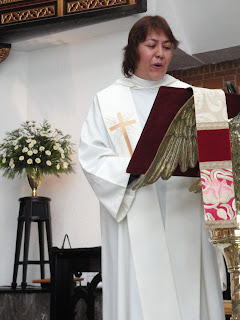Anyway, I usually go shopping for my day off, but decided to get a real rest and do something different. Mexico City is a great place for anyone who likes museums (someone like me, for instance) because there are more museums here than in any other city in the world. I decided that I would go to the Museum of Modern Art, which is within walking distance of the house. (A long walk, but a walk nonetheless).
As luck would have it, the permanent exhibits were closed. Either there was no explanation, or I didn't understand the explanation that was given to me by the person at the main desk. In any event, I was prepared to enjoy a relaxing day at a museum, and I was not about to be deterred. So I decided to go to the Museo Nacional de San Carlos, which was a bus ride away, near the center of the city.
 It is housed in a seventeenth century hacienda, with an open-air sort of courtyard. Like many of the large homes of that era, it was eventually abandoned, and used for another purpose. This grand home was used at one point as a tobacco factory (the neighborhood to this day is known as "tablaclera.") As luck would have it, about half of the permanent exhibit was closed. Only the Medieval, Renaissance, and Baroque exhibits were open. However, it was enough. Here are a couple of examples of the kind of things I was able to see.
It is housed in a seventeenth century hacienda, with an open-air sort of courtyard. Like many of the large homes of that era, it was eventually abandoned, and used for another purpose. This grand home was used at one point as a tobacco factory (the neighborhood to this day is known as "tablaclera.") As luck would have it, about half of the permanent exhibit was closed. Only the Medieval, Renaissance, and Baroque exhibits were open. However, it was enough. Here are a couple of examples of the kind of things I was able to see.  There was also a marvelous Spanish baroque oil painting of Christ washing the feet of his disciples, which was my favorite in the whole museum. As I looked at it, I thought to myself that I might be able to refer to some of the imagery of that painting in a sermon some day!
There was also a marvelous Spanish baroque oil painting of Christ washing the feet of his disciples, which was my favorite in the whole museum. As I looked at it, I thought to myself that I might be able to refer to some of the imagery of that painting in a sermon some day!
One of the weird aspects of the museum was that the temporary exhibit (of an artist whose name escapes me) was actually displayed side by side with the permanent exhibit, as a kind of commentary on the works displayed from each era. Here is the collage displayed in the room with Spanish Baroque art.
After the Museo San Carlos, I walked a few blocks to the Church of San Fernando, which also is home to one of Mexico's important cemeteries. Although my grasp of Mexican history is weak enough that I couldn't and didn't identify many of the heroes who were buried there, it was still an impressive and interesting monument.
The Church dates from the 17th century -- or was it the 18th...? At any way, it boasts another extraordinary gilded altar frontal and an elaborate carved exterior.
















